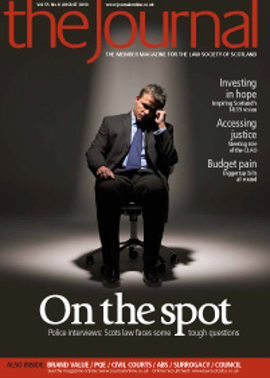Time to take a stand?

Disputes between parties over child-related matters are fraught with difficulties, not least because of the variance in advice to be given where the outcome can very much depend on the lottery of which sheriff hears a client’s case. More often than not, the issue of contact is resolved at the child welfare hearing, where sheriffs must “seek to secure the expeditious resolution of disputes” (OCR, rule 33.22A(4)). But in doing so, are we missing the point in relation to some commonplace and serious concerns in relation to the welfare of the child?
It is fairly unusual for a case on contact to go to proof when clients are ordained or cajoled into facilitating contact after one or more child welfare hearings, and possibly against the background of reporters who are sometimes asked to give recommendations on matters well beyond their skillset. In a case which did reach proof, it is interesting to see how one sheriff, after evidence, interpreted the relevant provisions of the Children (Scotland) Act 1995.
Extent of abuse
In SGR v LR (Edinburgh Sheriff Court, 21 June 2010) the defender had three children, two boys aged 14 and 12 and one daughter, A, aged nine at proof. The pursuer (S) was the younger boy’s father. The whereabouts of A’s biological father were unknown and she believed S was her father. Parties had separated in December 2008; S sought parental responsibilities and rights in respect of A as well as an order for contact.
Parties admitted their relationship had been volatile. There was evidence of excessive alcohol consumption by S. Sheriff Holligan found that S had physically assaulted the defender (L) and the boys more than once. S had never physically assaulted A, but the sheriff accepted that A would become upset at these incidents.
He also accepted that S had a “genuine affection” for A and had helped her with various activities.
The curator appointed to A reported that A was frightened of S and scared of seeing him, although did want S to write to her.
The sheriff considered s 11(7)-(7E) of the 1995 Act, as amended by the Family Law (Scotland) Act 2006, which sets out clearly those matters the court required to take into account when determining the issue of contact.
He suggested that the definition of “abuse” (subs (7C)) was deliberately wider than the dictionary definition as it included “abuse of a person other than the child”. He then considered s 11(7B). By paras (a) and (b) the court must have regard to the need to protect the child from “(i) any abuse; or (ii) the risk of any abuse, which affects, or might affect, the child”, and “the effect such abuse, or the risk of such abuse, might have on the child”.
The sheriff held that S’s behaviour towards L and the boys amounted to “abuse” within the Act and that it was not in A’s interests to be exposed to the risk of such abuse, in terms of s 11(7B)(a) and (b). Additionally, he looked at subs (7D), which provides that where in pursuance of an order the court is considering, “two or more relevant persons would have to co-operate with one another as respects matters affecting the child, the court shall consider whether it would be appropriate to make the order”.
In his view, the wording suggested that the “two or more relevant persons” must be two distinct people, not including the person applying for the order. Regardless of this, he deemed it appropriate to consider the relationship between the parties as potentially relevant to determination of welfare. On the parties’ relationship, the sheriff found that granting the order would “inevitably” lead to conflict between S and L.
Genetic advantage?
Regarding S’s non-paternity of A, L’s solicitor submitted that genetic link should “weigh heavily” with the court and was “one of the crucial parts of the welfare test”, so that a non-biological parent “has a higher hurdle to surmount” (para 20).
The sheriff rejected this argument, saying that it came “perilously close” to raising issues of onus. Indeed, he felt that the lack of biological link might actually go in S’s favour as, despite the lack, he still wanted contact.
Sheriff Holligan’s analysis of s 11 brought him to the conclusion that S should not be granted parental responsibilities and rights, but that an order limited to letterbox contact with A should be granted.
For those of us regularly appearing in child welfare hearings, such an analysis of the welfare principle may provide a useful reminder that, where merited, perhaps we as practitioners require to be a little more tenacious in holding our ground, and where appropriate proceed to proof?
- Fiona Sasan, partner, The Morton Fraser Family Law Team
In this issue
- From Cadder to Calman via Constitution
- We can make the bill work
- The Cadder effect
- Bio Quarter: a case study
- Budgets of many colours
- Been there, done that
- Gill and the consumer
- Smoothing the path
- Net yourself a baby
- What's in a name?
- Inspiring change
- Further work in hand on constitution
- Faculty support on the agenda
- PCC's first year of "unsatisfactory" complaints
- From the Brussels office
- Learning in context
- Paper, pixel and process
- Growing cloud
- Ask Ash
- PQE: Post Qualification Equality?
- Technology to the rescue?
- "Definitive" approach
- Threat, or opportunity?
- Equality for all?
- Time to take a stand?
- A burden discharged
- The promise of certainty?
- A future for crofting
- Final tally
- Website review
- Book reviews
- An easy way to give?
- Three cheers for iPad






